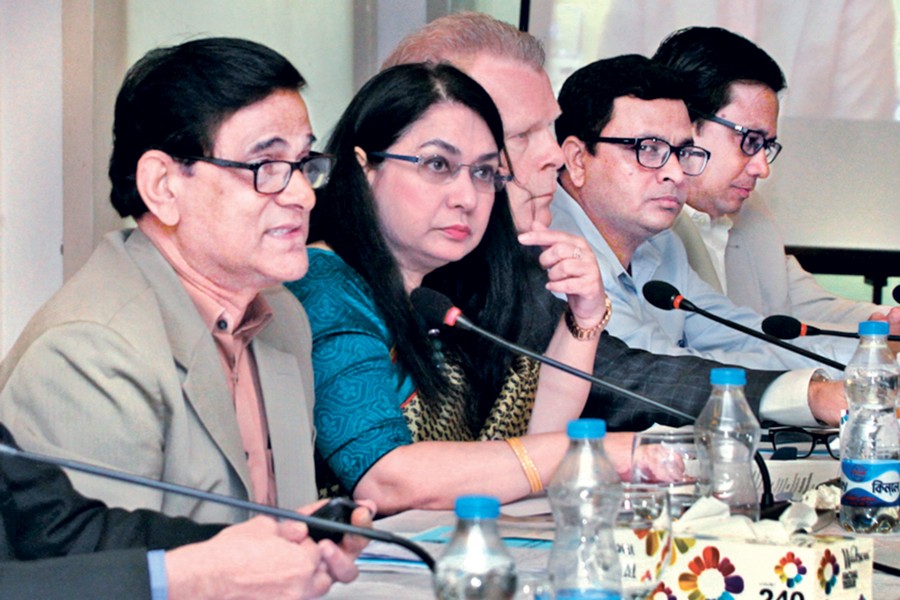
Leaving out women could hurt demographic dividend pursuit
56.9pc women not in education, employment, training, says CPD
FE Report | Thursday, 10 May 2018

The low participation of women in the work force could seriously hurt Bangladesh's chance of tapping the demographic dividend, the local think-tank Centre for Policy Dialogue (CPD) has warned.
About 56.9 per cent of women in Bangladesh are not in education, employment and training and as such, the country is missing out on significant opportunities, the CPD has cautioned.
Their observations came at the public dialogue on "Promoting Female Employment in Bangladesh for Realising Demographic Dividends" in the capital on Wednesday.
"Female labour force participation in Bangladesh continues to be significantly lower than their male counterparts," said CPD Distinguished Fellow Professor Mustafizur Rahman in his keynote presentation.
"While the female labour force's participation posted a rise between 2000 and 2010, it came down between 2010 and 2013, rising somewhat thereafter to reach the 2010 level in 2016-17", he added.
Citing some earlier studies done by the CPD, the researchers noted that while the national real average wages in Bangladesh fell by 2.5 per cent between the fiscal year (FY) 2015-16 and the FY 2016-17, for females it declined by 3.8 per cent,
While 85.1 per cent of the total employment in Bangladesh in the FY 2016-17 was in the informal sector-for females, the share was 91.8 per cent, they said.
Noting the country's failure to take women on board to tap their true contribution to the economy, the CPD researchers also noted that the value of women's unaccounted labour was equivalent to about 77 to 87 per cent of Bangladesh's gross domestic product (GDP).
Analysing the prevailing wage gap between males and females, speakers at the programme observed that the overall wage gap originated primarily from the unregulated informal employment.
"The average wage gap between informally-employed male and female employees is 14.3 per cent where 8.4 per cent originates from labour market discrimination against women and 5.9 per cent from characteristics effect", Mustafizur said.
"Among the sectors, agriculture has the highest wage gap of 17.3 per cent followed by 11.6 per cent in the services sector while the wage gap is lowest in the industrial sector at 9.9 per cent", he added.
Suggesting remedies for the situation, the CPD researchers have observed that it is important to identify barriers to formalisation and take gradual steps to promote formal employment and formal sectors in the economy.
At the same time, special efforts need to be taken for incentivising women's employment in the emerging rural non-farm sectors, they said.
"The unpaid household services provided by women should be taken into account in our national accounting system", said Planning Commission Member Professor Dr. Shamsul Alam.
"We need to find ways and methods of doing it", Professor Alam said. "Leading economic think-tanks can help us in this regard," he added.
Noting that the informal sector is often exploitive and less productive offering low wages, the Planning Commission member said, "For inclusive growth, we need to reduce this informal sector as much as possible and as quickly as possible".
Noting the overwhelming presence of women in the informal sector, Senior Research Fellow of Bangladesh Institute of Development Studies (BIDS) Dr. Minhaj Mahmud said, "The issues of maternity leave and paid overtime need to be addressed in the informal sector to address the plights of women working in such a segment".
Speakers at the programme also observed that the issue of women labour force's participation should be accorded more prominence in the upcoming 8th Five-Year Plan, Vision 2041 document and the SDGs implementation plan of the country "Bangladesh's voluntary national reports (VNRs) in the context of the SDGs should monitor progress with regard to various dimensions of FLFP in light of the relevant SDG targets and indicators," said Mustafizur.
Highlighting the important role of education in increasing women's participation in the labour force, the researchers said there is a need to blend vocational training with women's education to enable greater and gainful labour force participation in job markets of the future.
At the same time, ensuring women's education beyond the high school level should be seen as an important job market strategy for women, particularly in view of the opportunities of the emerging 'new economy', they said.
mehdi.finexpress@gmail.com